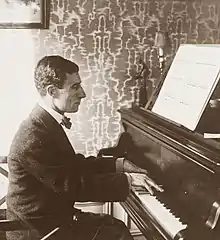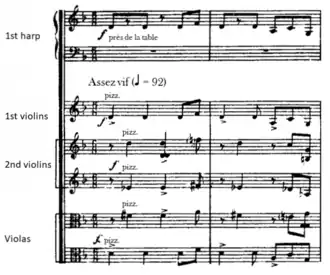
Alborada del gracioso ("The Jester's Aubade", or other translations: see below) is a short orchestral piece by Maurice Ravel first performed in 1919. It is an orchestrated version of one of the five movements of his piano suite Miroirs, written in 1904–05. Originally created for a ballet, the work has entered the concert repertoire, and has been recorded frequently.
Title
The title, in Spanish, has no exact English translation. It has been various rendered as "Morning Song of the Clown",[1] "The Jester's Aubade",[2] and "Morning Song of the Buffoon".[3] Alborada, literally "dawn", has a variety of musical meanings: it can be a lively folk-dance,[4] a Galician folk tune,[5] a type of rhythmically free instrumental music played on bagpipes and small drum,[6] a song for a wedding day,[4] or, as it is usually construed in the context of Ravel's piece, a musical announcement of dawn, a sunrise song, the equivalent of a French or English aubade.[7][8] In that sense, the roots of the term can be traced to the old troubadour and trouvère tradition in which the song portrayed the parting of two lovers at dawn.[9] A gracioso was a figure from Spanish comedy, variously described as a jester or a clown,[4] the classic genial buffoon,[9] the standard grotesque lover, akin to Don Quixote, of ancient Castilian comedy,[10] a humorous or amusingly entertaining person,[11] and a servant or squire who often comments satirically on the actions of his superiors.[12]
Background
In the years 1904–05, as he was finishing his String Quartet, Ravel composed Miroirs (Mirrors), a suite of five short piano pieces.[13] He later orchestrated two of them: the orchestral version of "Une Barque sur l'océan" (A Barque on the Ocean) came out in 1906;[14] more than a decade elapsed before Ravel orchestrated the other, the "Alborado del gracioso".[14]
The orchestration came about at the invitation of Sergei Diaghilev, the impresario of the Ballets Russes. He was well acquainted with Ravel, having commissioned from him the music for Daphnis et Chloé in 1909. Diaghilev visited Spain for the first time in 1916 and was so taken with the country that he commissioned several ballets on Spanish themes. The first appeared in the same year: Leonid Massine's Las meninas, inspired by Velázquez's painting of the same name. It was danced to a composite score that included "Alborada del gracioso" (in its piano version) along with Gabriel Fauré's Pavane and pieces by Louis Aubert and Emmanuel Chabrier.[15] Diaghilev commissioned Ravel to orchestrate the Alborada (and the Chabrier piece, the Menuet pompeux) for a production of the ballet, retitled Les jardins d'Aranjuez, at the Alhambra Theatre, London in 1919.[16] Before the ballet opened in London the orchestral Alborada was premiered in Paris on 17 May 1919 by the Pasdeloup Orchestra conducted by Rhené-Baton.[17]
Music

The music consists of two sections of lively dance music, separated by a rhapsodic, extended song.[18] The opening is marked assez vif (fairly quick), ♩ = 92.[19] Like the piano original, the piece begins with imitations of guitar music. In the orchestral version they are produced by the first harp, played close to the sound board, along with precisely arranged pizzicato violins and violas.[20] The basic metre of the opening section is 6
8 but Ravel varies it with occasional bars of 3
8 and 9
8.[4]
The music is mainly quiet for the first 28 bars as the themes are established. They are then brought together in what the commentator Eric Bromberger describes as "a great explosion of sound, subtly tinted by Ravel's use of castanets, tambourine, cymbals and harp".[4] and then a fortissimo chord introduces the central episode, a plaintive 3
4 melody for solo bassoon – the clown's song – alternating with shimmering string sonorities.[4][21] To represent the sounds of the extreme treble of the piano original, the accompaniment to the bassoon melody is scored for 24-part strings, some instruments bowed, others plucked, and deploying a range of harmonics, multiple stops and sul tasto effects.[20]
The music makes a gradual return to the original tempo; Ravel added four bars to the original score here, making use of woodwind tremolos.[2] The piece builds to a conclusion and ends in what critics have variously described as "a blaze of orchestral color",[21] "an exhilarating climax",[22] and "a grand and glorious racket".[10]
Recordings
The first recording of the orchestral Alborada del gracioso was made by the Berlin State Opera Orchestra, conducted by Otto Klemperer in 1926.[17] Since then there have been numerous versions on record. In a comparative survey of recordings for BBC Radio 3, Rob Cowan short-listed the following:[23]
| Orchestra | Conductor | Year |
|---|---|---|
| Suisse Romande | Ernest Ansermet | 1951 |
| Orchestre national de la Radiodiffusion Française | André Cluytens | 1953 |
| Paris Conservatoire | Albert Wolff | 1959 |
| Suisse Romande | Ansermet | 1960 |
| Philharmonia | Carlo Maria Giulini | 1960 |
| Paris Conservatoire | Cluytens | 1962 |
| Detroit Symphony | Paul Paray | 1963 |
| Orchestre de Paris | Herbert von Karajan | 1971 |
| Boston Symphony | Seiji Ozawa | 1974 |
| Orchestre de Paris | Jean Martinon | 1975 |
| Montreal Symphony | Charles Dutoit | 1983 |
| Orchestre national de France | Eliahu Inbal | 1987 |
| London Symphony | Claudio Abbado | 1989 |
| Berlin Philharmonic | Pierre Boulez | 1994 |
| Orchestre de Paris | Christoph Eschenbach | 2004 |
Recordings recommended by other critics include:
| Orchestra | Conductor | Year | Ref |
|---|---|---|---|
| Chicago Symphony | Fritz Reiner | 1958 | [24] |
| Philadelphia Orchestra | Eugene Ormandy | 1960 | [25] |
| Royal Philharmonic | André Previn | 1986 | [26] |
| Dallas Symphony | Eduardo Mata | 1988 | [25] |
| Ulster Orchestra | Yan Pascal Tortelier | 1993 | [27] |
In 2015 the conductor François-Xavier Roth and the orchestra Les Siècles, which specialises in historically informed performance, released a recording of the Alborada using original or reproduction instruments of the period.[28]
References and sources
References
- ↑ Nichols, p. 93
- 1 2 Orenstein, p. 159
- ↑ Baker, p. 22
- 1 2 3 4 5 6 Bromberger, Eric. Programme note Archived 2 April 2016 at the Wayback Machine, San Diego Symphony Orchestra, 15–17 May 2015, pp. 4–6
- ↑ Chase, p. 232
- ↑ "alborada" Archived 5 March 2021 at the Wayback Machine, The Oxford Companion to Music, Alison Latham (ed.), Oxford University Press, 2011. Retrieved 4 March 2021 (subscription required)
- ↑ "aubade". Oxford English Dictionary (Online ed.). Oxford University Press. (Subscription or participating institution membership required.)
- ↑ Chase, p. 232; and Lee, p. 318
- 1 2 Lee, p. 318
- 1 2 Huscher, Phillip. Programme note Archived 10 August 2017 at the Wayback Machine, Chicago Symphony Orchestra. Retrieved 3 March 2021
- ↑ Keller, James M. Programme note Archived 4 March 2020 at the Wayback Machine, New York Philharmonic Orchestra. Retrieved 3 March 2021
- ↑ Anderson, Robert. Notes to Naxos CD 8.572887
- ↑ Nichols, p. 400
- 1 2 Nichols, p. 399
- ↑ " Las meninas" Archived 27 March 2019 at the Wayback Machine, Bibliothèque nationale de France. Retrieved 3 March 2021
- ↑ Nichols, pp. 202–203
- 1 2 Nichols, p. 203
- ↑ Maycock, Robert. " Alborada del gracioso" Archived 25 February 2019 at the Wayback Machine, BBC, 2014. Retrieved 5 March 2021
- ↑ Ravel, p. 3
- 1 2 Russ, pp. 135–136
- 1 2 Schiavo, Paul. Notes to Seattle Symphony Media CD SSM 1002
- ↑ Goodwin, Noël. Notes to Chandos CD CHAN 8850
- ↑ "Ravel: Alborada del gracioso" Archived 5 March 2021 at the Wayback Machine, CD Review, BBC Radio 3, 2014. Retrieved 5 March 2021
- ↑ Svejda, p. 152
- 1 2 March et al., p. 1502
- ↑ March et al., p. 1503
- ↑ March et al., p. 1050
- ↑ Clements, Andrew. " Chabrier; Massenet; Ravel; Debussy CD review – joyous and wonderfully vivid" Archived 22 December 2015 at the Wayback Machine, The Guardian, 11 June 2015
Sources
- Baker, Richard (1979). Richard Baker's Music Guide. Newton Abbot: David and Charles. ISBN 978-0-71-537782-6.
- Chase, Gilbert (1942). The Music of Spain. London: Dent. OCLC 12178522.
- Lee, Douglas (2002). The Modern Repertory of the Symphony Orchestra. New York: Routledge. ISBN 978-0-41-593846-4.
- March, Ivan; Edward Greenfield; Robert Layton; Paul Czajkowski (2008). The Penguin Guide to Recorded Classical Music. London: Penguin. ISBN 978-0-141-03336-5.
- Nichols, Roger (2011). Ravel. New Haven: Yale University Press. ISBN 978-0-30-010882-8.
- Orenstein, Arbie (1991) [1975]. Ravel: Man and Musician. Mineola, US: Dover. ISBN 978-0-486-26633-6.
- Ravel, Maurice (1920). Alborada del gracioso: orchestral score (PDF). Paris: E. Demets. OCLC 993665100.
- Russ, Michael (2000). "Ravel and the orchestra". In Deborah Mawer (ed.). Cambridge Companion to Ravel. Cambridge: Cambridge University Press. ISBN 978-0-521-64026-8.
- Svejda, Jim (1995). The Record Shelf Guide to Classical CDs. Rocklin: Prima. OCLC 103681656.